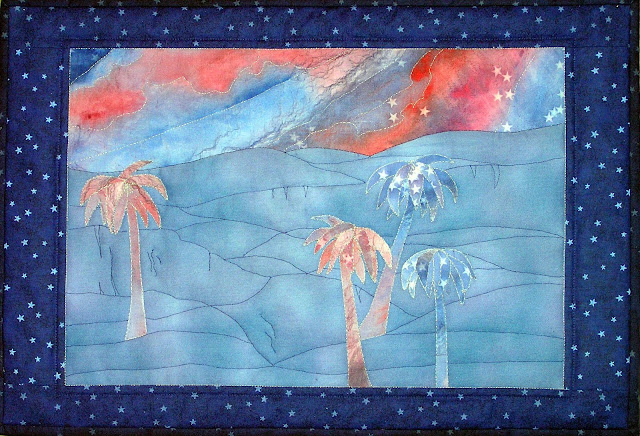Quilt No. 108
December 2015
Every so often a
challenge will come your way. Sometimes
you duck it, sometimes you plunge head long into it, throwing caution and your
underwear into the wind. Light and Dark in the City was kind of
like that. And it all started with a
paper bag.
A couple of weeks
before Christmas a “paper bag challenge” was announced at quilt guild. It works like this. Fabric, notions and sometimes other non-cloth
fibre items are put into a small paper bag. Batting is included, and the quilter who
receives the bag must make a small quilt with only the items found in the bag.
She can use her own thread and tools, but she may not add any fabric to
it. Sounds pretty simple. Until you open the bag.
 |
| Some of the items in the paper bag. |
I’ve never gotten to
do one of these before. Generally, there
are only two paper bags, for two lucky quilters. People who want to give this a shot put their
names in a draw. This particular time not
too many people entered. Everyone was
eyeball deep in Christmas preparations at home and the project had to be
completed by the next meeting, a measly two weeks away. My odds of winning one of the bags were
considerably better than usual with fewer names in the draw. And I was pretty darn pleased when my name
was announced.
The bag contained about
twenty pieces of fabric in solid colours, or “solids” in quilt world jargon. The colours were completely random, not
necessarily colours you would intuitively partner up together. There was one print – a black fabric with
small white dots. All these pieces were
fairly small and varied in size. Also
included was a placemat sized piece of batting, and two larger pieces of black
cotton. And...a tiny baggie with red, green, and black woolish pieces in it. I heard someone behind me say, “Oh, there’s
roving too.” I pretended to know what
that meant. Someone else said, sagely,
“Ah, for felting.” Roving? Felting? Was it too late to re-raffle the paper bag? I was supposed to create a quilt and learn
how to felt in two weeks? All while
Christmasing-up my house? Gulp.
I brought the paper
bag home and placed the pieces on my quilting table. There were a lot of longish strips –
immediately the idea of doing skyscrapers came to me. I am quite fond of quilting cities (Before,
Blue collar). There wasn’t a lot of time to ruminate about
it. Sometimes I can spend way more than
two weeks just
thinking about a quilt
before I start designing. This was not
going to be one of those times.
 |
| "Before" a city quilt I made after 9/11. |
To get myself started
I consulted my favourite coffee table book, Skyscrapers. This book profiles several famous buildings
and gets your mind past the idea that all buildings are tall boxes that are stubbornly
rectangular. It launched my project with
a few buildings that were varied in shape, allowing me to comfortably default back
to my own building creations...all of which were rectangular boxes.
I wanted to create a
harbour skyline, a long one. However,
this was limited by the size of the batting, which was cut to the dimensions of
a placemat. Ha! Limiting factor or not, I could at least alter
the batting into a long and narrow shape by cutting and piecing it, two
activities that basically define quilting. This generated a new limiting factor – I now had a maximum of 8 ½ inches
for those tall skyscrapers. Not much
room left for the water – and no city skyline looks quite right unless it’s on
water. Night time city skylines also
have those grand reflections in the harbour water – I wanted to capture those
too. There was just enough room to squeeze in some light reflections using my favourite shiny rayon thread.
To use up the roving -
whatever it is - I machine quilted over it to create clouds. Learning to felt would have to wait for another
day. Or another challenge.
I finished the piecing
and the quilting and turned to my carefully conserved strips of black that I’d
saved for the binding. I was four inches
short. I had three other pieces left that were big
enough to help me out – white, hot pink, and the black/white dot piece. I decided to use the hot pink. To make it look like I’d planned it that way
all along, I ran the pink fabric through the printer and printed out the name
of the quilt on it. After many test pieces I was able to sew it on
so that the words lined up centered in the quarter inch wide piece of pink on
the binding. Alas, the pink was then too
dominant and distracting. I fused in some strips of black to
de-emphasize it as much as I could. It
would have to do – painting black over the pink would have sent me straight to
the cheater’s list.
 |
| Julie and Linda with their tale of two cities. |
I willed myself not to
email Linda, the quilter who was doing the same challenge, to see if she would divulge what subject she had chosen
for her paper bag project. When it
came time to reveal the quilts at the meeting, we were flabbergasted to find
that both of us had created cities. The
cities were radically different with mine horizontal and narrow and distant,
and hers an intimate close-up of a warm urban place with an actual felted tree
and a felted roof.
I would have to say that I truly learned a lot from
this challenge. But, nope, I didn't learn how to do felting. I'm saving that for another day.



















